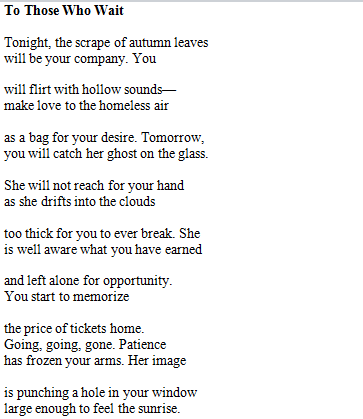by Jacob Richard Cumiskey
My name is Jacob, and I am a twenty-one year old undergraduate at Warren Wilson College studying poetry. I have a disability known as Asperger syndrome: an Autism Spectrum Disorder that manifests itself through extreme discomfort in most social situations and difficulties in non-verbal communication. The phrase “non-verbal” can be a bit misleading here, because while I personally have a very difficult time reading body language from my friends or hand signals from my parents, I have a very comfortable time communicating to the world through my writing. I have been writing poetry for around nine years, and I believe there may be reasons linked to my disability as to why poetry comes more naturally to me than socializing, and the truth behind these reasons might not just be important for the autistic community to understand, but for the state of Florida to know as well.
Autism has become a hot word in our state recently, but there seems to be some pretty dangerous patterns regarding people’s initial take on what having an Autism Spectrum Disorder (an ASD) means. There is this tendency to either reduce individuals with an ASD to people with basic social anxiety or demonize them to the point of labeling their behavior as intentional social deviance. Doctors and scholars naturally have a much more empirical view on ASD—having linked differences in social behavior with differences in brain structure— but in my opinion, the ways in which the general public is learning about autism these days is extremely silly. The behaviors of a shark need to be researched from afar because we cannot ask the shark why it does the things it does, but some people with autism can be asked what their life is like and explain directly (or indirectly) what autism means to them.
The arts are an easy example of how this can be accomplished.
First and most important, eye-to-eye discussion is not always necessary with art, and so just about any artistic medium can act as an outlet for people with an ASD to discuss things they wouldn’t normally be comfortable talking about. Writing, for example, creates a safe environment where it is just the person and some paper. A blank page (or canvas, or journal) is the perfect listener and has zero social expectations for the artist, and this makes all the difference in terms of comfort. As someone with autism myself, one of the main reasons why I chose to write poetry over other forms of artistic expression is because it gives me the chance to speak without having to be spoken to or observed. I feel safe when writing because essentially nothing is expected of my behavior when I am alone with the page, unlike just about every other moment of my life. Poetry provides an opportunity for me to feel easy about my own thoughts, and so instead of forcing kids and adults with an ASD to participate in uncomfortable social experiences in order to help them “grow,” doesn’t it make more sense to allow the autistic community a means to indirectly communicate with neurotypicals through the arts? Wouldn’t art be an effective way to help people with autism grow comfortable with their own voice?
The arts can be no replacement for day-to-day communication, I know this, but art also creates the chance for normally unacceptable forms of communication to be celebrated and allows for an individual’s confidence to build. Through poetry, I may not have immediately begun socializing with other people, but I slowly learned to feel confident and safe with my own thoughts, and this confidence is the key to prosperous social interaction. In time, I hope our state will begin notice this valuable correlation between autism and the arts even more. So many people with an ASD are relentlessly treated like social pariahs by their peers; at the very least, it is essential for people on the autism spectrum to have a place where thoughts can be explored safely. Poetry is this for me, and I hope it might already be this for a few other people with an ASD as well.
As a personal example of the concepts I have been talking about, recently a good friend of mine asked me how I feel being in a long-distance relationship. Because of my autism, this was naturally a hard question for me to answer in the moment, and so I began working on a response to this through poetry. Writing this was not only more comfortable for me personally, but I feel as if it became a more effective form of communication than me just speaking on the subject immediately. What do you guys think?
Jacob Cumiskey recently spoke at the Florida Alliance for Arts Education 2014 summit in a session entitled “Access through the Arts: One Student’s Journey to the Neurotypical World in the Public School Setting.”




